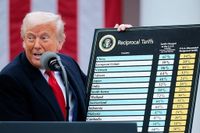The recent imposition of a 30% tariff on South African goods by US President Donald Trump has raised significant concerns among stakeholders in South Africa's mining and export sectors. This decision, announced on April 2, 2025, is part of a broader strategy by the Trump administration to enforce reciprocal tariffs on countries perceived to impose high trade barriers against US imports.
While the tariffs will affect certain commodities, notably iron-ore and diamonds, the Minerals Council South Africa has noted that key exports like platinum group metals (PGMs), coal, gold, manganese, and chrome are specifically excluded from these tariffs. This exclusion is seen as a double-edged sword, as it does not alleviate the broader concerns regarding the potential negative impact on global economic growth and demand for South African minerals.
"Despite the exclusions, we remain concerned about the adverse impact on business and consumer sentiment and the resultant feedthrough to business investment, consumer spending and ultimately global real GDP growth caused by this unprecedented upheaval in world trade," said Minerals Council chief economist Hugo Pienaar. The council's apprehension is rooted in the belief that reduced demand for South African exports could have a ripple effect, dampening economic growth.
In 2024, South Africa's total exports of mineral products and precious metals to the US reached R65.3 billion, with PGMs accounting for a staggering 76.3% of that total. The significance of PGMs in the automotive industry cannot be overstated; they are essential for manufacturing autocatalysts that reduce vehicle emissions. However, Pienaar warns that increased vehicle prices in the US, resulting from a 25% tariff on all vehicle imports, could slow demand for automobiles and subsequently reduce the need for PGMs.
"If car and truck sales slow, demand for PGMs will reduce and result in volatile near-term prices," Pienaar added. On a more optimistic note, the Minerals Council remains hopeful about the long-term outlook for PGMs, citing opportunities for growth in market development, particularly with the rise of green technologies and internal combustion engines.
South Africa is recognized as the world's leading source of PGMs, manganese, chrome, and vanadium, all of which are critical as energy metals. This position offers a unique advantage, especially as global demand for energy transition materials increases. Furthermore, the gold price remains robust, consistently above $3,000 per ounce, providing a buffer against economic uncertainties.
CEO of the Minerals Council, Mzila Mthenjane, emphasized the potential for a weaker rand against the dollar to enhance the competitiveness of South African exports. "If sustained, orderly and not accompanied by notable domestic cost increases, the weaker rand should increase the competitiveness of South African mineral and other exports," Mthenjane stated.
However, the implications of Trump's tariffs extend beyond just the mining sector. The US's claim that South Africa imposes a 60% reciprocal tariff on its goods has been contested by trade experts. Donald MacKay, CEO of XA Global Trade Advisors, pointed out that the average tariff applied by South Africa is closer to 7.5%. This discrepancy raises questions about the fairness and accuracy of the US's tariff strategy.
MacKay noted that the US's method for calculating these tariffs seems flawed. According to the Financial Times, the White House's approach involves taking the US's trade deficit with a country, dividing it by the total amount of goods imported from that country, and then halving that percentage to arrive at a 'reciprocal' tariff rate. For South Africa, this calculation has led to an inflated tariff figure that does not reflect the actual trade practices.
The new tariffs are expected to disrupt the African Growth and Opportunity Act (AGOA), which has allowed South Africa duty-free access to the US market for over 1,800 products, including citrus and wine. The potential loss of this access could have far-reaching consequences for South African exporters.
As countries around the world prepare to respond to the US's tariff measures, many are expected to announce countermeasures in the coming days. The global trade landscape is poised for significant shifts as nations react to what many view as an aggressive and unilateral approach by the Trump administration.
Economists have expressed concern that Trump's tariff strategy could dampen growth, weaken the rand, and lead to job losses in South Africa. The long-term effects of these tariffs may take time to fully materialize, but the immediate uncertainty is palpable.
As the situation unfolds, stakeholders in South Africa's mining and export sectors will be closely monitoring developments. The exclusion of key minerals from tariffs may provide some relief, but the overarching concerns about global economic stability and demand remain pressing. The coming months will be critical in determining the trajectory of South Africa's trade relations with the US and the broader implications for its economy.





